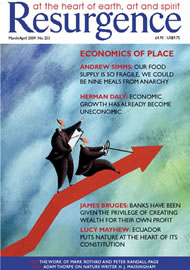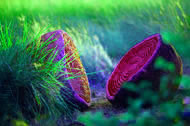THE RUWENZORI SCULPTURE Foundation recently organised an expedition to the remote island of Lolui in Lake Victoria, Uganda. Dangerous and inaccessible, beautiful and mysterious thanks to its neglected ancient history, Lolui made the ideal location for a multi-disciplinary, bicultural Arts project that needed to find new yet common ground for all the participants involved.
Granite boulder clusters, some the size of tower blocks, bulge above the surface of the island, forming a natural sculpture park of beautifully rounded, organically shaped rocks that instantly bring to mind Peter Randall-Page’s raw material. Spiralling, maze-like Neolithic ochre paintings found on the rocks reinforced the Foundation’s wish to bring Peter to confront and respond to this poetic ancestry, both natural and human. The Ugandan painter and sculptor, Peter Oloya – a former child soldier who uses sculpture as a form of therapy to help other victims of war – was chosen to partner him in a quest to create new monuments to the island and its forgotten cultural inheritance.
Hidden among some of the accretions of tumbled stone lie prehistoric rock gongs, natural phenomena barely known and probably unplayed since long before the island was evacuated in 1907 due to sleeping sickness. So how did it sound – that original rock music? These rock gongs are a direct connection to our evolution, the birth of music and art, and provide endless possibilities for fresh, contemporary, creative expression.
The London Sinfonietta, acclaimed for its exciting commissions and daring musical collaborations, was an ideal choice of partner for the project. In contrast, Uganda’s vibrant musical traditions were represented by Uganda Dance Academy, an organisation dedicated to preserving and performing traditional Ugandan songs, dances and music. Throughout the project, the two groups united in their goal to awaken the melodies within the sleeping gongs. They achieved some astounding results.
THE ARTISTS ABSORBED the atmosphere: the surreal rocky environment, the blue lake, the people, the smells of drying fish and bonfires, the large, sweeping prairies of willowy grass, the birdsong, forest and granite. The sand, made up of pulverised granite, crunched underfoot on the trudge to the first gong. With a commanding view over the north of the island, amid hundreds of tons of bulbous boulders, balanced precariously on three smaller stones, sits the Singla Rock. Deep in the delicious, cool shade that only a cave can provide, the gong itself waits.
Overhead are red-ochre patterns of spots, handprints and lines, painted in Neolithic times. Intriguingly, a cross, also in red ochre, has attracted the attention of a Christian sect – some of the recent island settlers – who have now adopted the shady protection of the gong as their church, their candle-wax evidence of new life and use for what must have been an ancient spiritual site. Deep, round depressions, testament to the rock gong’s age and use, indicate where this prehistoric instrument rings the finest of its twenty-one notes.
Without hesitating, and as if they had always played the rock gong, the Ugandan musicians exploded it into life. Sharp, hard, staccato, bell-like ring-tones and a fundamental deep bass shattered in an instant the suspicion that the rock might only produce a dull thud. Everyone present was amazed by the diversity of sounds that could be played, and the team left exhilarated.
BACK AT THE camp, an egg-shaped rock that had split almost perfectly into two halves began to attract Peter Randall-Page’s attention. The coincidence that several of his early works used split boulders seemed providential and gradually he came to feel that he could perhaps make a piece of sculpture here, leave a mark and express his response to this remarkable place and its extraordinary history.
He reacted to the environment, filling sketchbooks, taking photographs, studying patterns in the skins of reptiles, the wings of insects, flowers and fish scales. His interactions with the musicians, fishermen and children were then shared in campfire discussions. History, painting and sculpture flowed between all the participants, irrespective of culture or discipline. Midnight photography, early-morning carving and improvisation sessions at dusk were all invigorated by the thrill of new discovery and the shared ambition to create something unique and meaningful.
Beating rock with rock, an action more akin to carving than to the notion of playing an instrument, brought forth sounds that everyone acknowledged struck a chord with an archaic or archetypal tune in all of us. Our sense of the universality of the language of art was reinforced by interaction with the local fishermen, whose responses were profound and complex. Gradually, Peter developed his experiences and emotions into the carving of the split boulder ‘Eginja Eriyimba’. Using spiral ochre patterns on the two faces, the concentric ripples echo out from the core, as much the ripples of culture from an ancient start as they are the mystery of sound emanating from solid granite.
That sculpture now stands permanently on Lolui, and since Peter’s return to the UK a fertile new body of work has arisen, inspired by the residency. He has produced series of prints exploring the landscape and patterns of the island that express the delicate balance of natural rhythms. Music and sculpture have continued to be close relatives in his new three-dimensional pieces and share the genetic inheritance of the musical rocks. Keeping the boulder core with its inherent weight, mass, strength and truth, painted or applied rhythmic patterns enhance and elaborate the original form through mathematical geometry.
Peter’s eloquent language, where humans and Nature harmonise, has created wonderful objects that, like music, tease our senses with form and pattern, rhythm and tone, creating a sensuous beauty of their own. •
This article was first published by Pangolin London to accompany the exhibition Rock Music, Rock Art. A short film of this expedition is at www.resurgence.org. Three bronzes and a series of lino-cuts created by Peter Randall-Page in response to this expedition can be seen at the Pangolin London gallery. www.pangolinlondon.com








